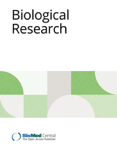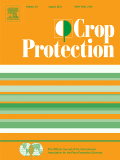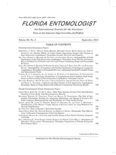
NEMATOLOGY
Scope & Guideline
Exploring the Intricacies of Nematodes
Introduction
Aims and Scopes
- Taxonomy and Systematics:
A core area of focus involves the identification and classification of nematodes, including the description of new species and revisions of existing taxa. This work is crucial for understanding the biodiversity of nematodes and their evolutionary relationships. - Ecological Interactions and Roles:
Research on the ecological roles of nematodes in various environments, including their interactions with plants, soil health, and their roles as bioindicators of ecosystem health. - Plant-Parasitic Nematodes:
Significant emphasis is placed on the study of plant-parasitic nematodes, particularly their impact on crop production, management strategies, and resistance mechanisms in host plants. - Entomopathogenic Nematodes:
The journal covers research on entomopathogenic nematodes, which are used as biological control agents against insect pests, exploring their effectiveness, mechanisms of action, and applications in integrated pest management. - Molecular and Genetic Studies:
Molecular characterization and genetic studies of nematodes are increasingly featured, focusing on phylogenetics, population genetics, and the use of molecular tools for diagnostics and understanding nematode biology. - Biocontrol and Management Strategies:
Research on nematicides, biological control methods, and sustainable agricultural practices aimed at managing nematode populations and mitigating their impact on crops.
Trending and Emerging
- Molecular Diagnostics and Genomic Studies:
There is a significant increase in research utilizing molecular techniques for diagnostics and phylogenetic studies. This trend is driven by advancements in sequencing technologies and bioinformatics, enabling more precise identification and understanding of nematode diversity. - Integrated Pest Management and Sustainable Practices:
Research focused on integrated pest management strategies, including the use of biological control agents and sustainable agricultural practices, is gaining traction as the agricultural sector seeks to reduce chemical inputs and enhance ecosystem health. - Nematode Biocontrol Innovations:
Emerging studies on the development and application of biocontrol agents, particularly entomopathogenic nematodes, are becoming more prominent. This reflects a shift toward finding environmentally friendly pest management solutions. - Impact of Climate Change on Nematode Dynamics:
Research examining the effects of climate change on nematode populations, distribution, and interactions with hosts is increasingly important, addressing the need to understand how global changes affect agricultural systems. - Nematodes in Soil Health Assessment:
There is a growing focus on the role of nematodes as bioindicators of soil health, with studies exploring their community structure and function in relation to soil management practices and environmental changes.
Declining or Waning
- Traditional Chemical Control Methods:
The focus on conventional chemical nematicides has decreased as there is a growing preference for sustainable and environmentally friendly alternatives. This shift is influenced by increased awareness of environmental impacts and regulatory changes. - Generalized Host-Pathogen Interaction Studies:
While specific studies on plant-parasitic nematodes remain prevalent, broader studies on host-pathogen interactions without a strong focus on nematode specifics have become less common, suggesting a trend towards more targeted research. - Studies on Free-Living Nematodes:
Research on free-living nematodes, although still relevant, has seen reduced emphasis compared to plant-parasitic and entomopathogenic nematodes, possibly due to a greater focus on applied research with direct agricultural implications.
Similar Journals

Vertebrate Zoology
Unraveling the Mysteries of Vertebrate LifeVertebrate Zoology is a prestigious open-access journal published by the Staatliches Museum Tierkunde Dresden in Germany, focusing on the intricate and diverse field of animal biology. With an ISSN of 1864-5755, the journal has established itself as a vital resource for researchers, professionals, and students in the realms of Animal Science and Ecology, Evolution, Behavior, and Systematics. Since transitioning to open access in 2021, it has expanded accessibility and global dissemination of research findings, showcasing significant studies that contribute to our understanding of vertebrate fauna. The journal's impressive Q1 quartile rankings in both Animal Science and Zoology, as well as Ecology and Evolution, underscore its influence within the academic community—ranking #95 and #220 in their respective categories according to Scopus. Spanning from 2011 to 2024, Vertebrate Zoology aims to provide a comprehensive platform for innovative research, fostering collaboration and advancing knowledge across the biological sciences.

Pesquisa Agropecuaria Tropical
Empowering innovation in agronomy and crop science.pesquisa Agropecuaria Tropical is a premier Open Access journal dedicated to advancing the knowledge and practices within the field of agronomy and crop science. Since its inception in 1971, this peer-reviewed journal, published by the Universidade Federal de Goiás, has played a pivotal role in disseminating high-quality research from Brazil and beyond. Operating under an Open Access model, it ensures that scholarly articles are freely accessible, thereby fostering greater collaboration and innovation. With a Scopus ranking placing it in the 32nd percentile among its peers in agricultural and biological sciences, and a current classification in the Q3 category of agronomy and crop science, the journal serves as an essential resource for researchers, professionals, and students alike. As it continues its publication journey from 2010 to 2024, it remains committed to contributing valuable insights and advancements in the agricultural sector, ultimately influencing sustainable practices and food security.

RUSSIAN JOURNAL OF NEMATOLOGY
Diving Deep into Nematode Ecology and EvolutionRUSSIAN JOURNAL OF NEMATOLOGY, published by the Russian Academy of Sciences, Institute of Parasitology, serves as an essential platform for disseminating comprehensive research on nematodes and their ecological significance. With a strong foundation since its inception in 1996, this journal addresses critical areas within the fields of Animal Science and Zoology, as well as Ecology, Evolution, Behavior, and Systematics, currently positioned in the Q3 category for both domains. In 2023, the journal ranks #216 out of 490 in Animal Science and Zoology, and #387 out of 721 in Ecology, reflecting its growing impact within the scientific community. Though it is not an open-access journal, RUSSIAN JOURNAL OF NEMATOLOGY remains a pivotal resource for researchers, professionals, and students seeking to advance their understanding of nematological science, particularly in the context of ecological interactions and parasitic relationships. Each issue synthesizes innovative research findings that contribute to the broader discourse on biodiversity and ecosystem health.

BIOLOGICAL RESEARCH
Transforming research into accessible knowledge.BIOLOGICAL RESEARCH is a prestigious, peer-reviewed journal published by the Société de Biologie de Chile, dedicated to advancing the fields of Agricultural and Biological Sciences, Biochemistry, Genetics, and Molecular Biology, and Medicine. With an impressive ranking in the top quartile (Q1) in these categories as of 2023, this journal maintains high academic standards and visibility, making it a vital resource for researchers and professionals alike. Operating under an Open Access model since 2013, it ensures that research findings are freely accessible to a global audience, promoting the dissemination of knowledge and collaboration across disciplines. With a publication history dating back to 1992 and continued updates until 2024, BIOLOGICAL RESEARCH serves as a crucial platform for innovative research that impacts both scientific and healthcare communities. The journal’s commitment to quality and relevance is evidenced by its competitive performance in Scopus rankings, further solidifying its role as a leading journal within the biological sciences.

NEW ZEALAND JOURNAL OF AGRICULTURAL RESEARCH
Innovating Solutions for Modern Agricultural ChallengesNEW ZEALAND JOURNAL OF AGRICULTURAL RESEARCH is a prestigious, peer-reviewed journal published by Taylor & Francis Ltd that has been at the forefront of agricultural science since its inception in 1958. With a strong focus on the fields of Agronomy and Crop Science, Animal Science and Zoology, Plant Science, and Soil Science, this journal has established itself in the academic community, achieving a notable Q2 ranking in various agricultural categories as of 2023. The journal thrives on its commitment to disseminating cutting-edge research and innovative practices that address contemporary challenges in agriculture. Although it does not currently offer an open access option, its valuable contributions can be accessed through various academic platforms, ensuring that vital research reaches a wide audience of researchers, professionals, and students globally. The journal's continued relevance and authority are reflected in its strong Scopus rankings, further emphasizing its role as a critical journal within the agricultural sciences.

Nativa
Connecting researchers to enhance our natural resources.Nativa, published by the Universidade Federal de Mato Grosso in Brazil, stands as a prominent open-access journal since 2013, dedicated to the dissemination of research across various domains of Agricultural and Biological Sciences. With its ISSN 2318-7670, Nativa aims to foster scholarly communication and collaboration among researchers and practitioners worldwide. The journal occupies notable positions within the Scopus rankings, with a Q3 classification in several categories, including Agricultural and Biological Sciences (miscellaneous) and Environmental Science (miscellaneous), while also holding a Q4 classification in areas such as Agronomy and Crop Science and Animal Science and Zoology. This positioning reflects its commitment to advancing knowledge and understanding crucial to sustaining and enhancing our natural resources. Nativa seeks to engage a diverse readership by providing a platform for innovative research, fostering interdisciplinary discourse, and addressing pressing environmental challenges and conservation efforts essential for sustainable development.

ANNALS OF APPLIED BIOLOGY
Elevating applied biology to meet global agricultural challenges.Annals of Applied Biology, published by Wiley, stands as a pivotal resource in the fields of Agronomy and Crop Science, boasting an impressive impact factor that reflects its significance and influence in the academic community. With a storied history dating back to 1914, this journal serves as a comprehensive platform for innovative research and applied studies in agricultural biology, specifically aimed at improving crop production and sustainable practices. Currently categorized in the Q1 quartile for Agronomy and Crop Science in 2023, it ranks an admirable 82 out of 406 in the Scopus database, placing it within the top 79th percentile of its category. Researchers, professionals, and students worldwide rely on the Annals of Applied Biology for cutting-edge insights and advancements in applied biological research, making it a vital component of the scientific discourse aimed at addressing pressing agricultural challenges. Please note that this journal does not offer open access options, thus ensuring a rigorous peer review process and the integrity of published work.

Crop Protection
Pioneering advancements in herbicide development and pest control.Crop Protection is a leading academic journal in the field of Agronomy and Crop Science, published by Elsevier Science Ltd, and recognized for its high impact demonstrated by an impressive Q1 quartile ranking in 2023. With its ISSN 0261-2194 and E-ISSN 1873-6904, this esteemed publication has been a crucial source of research since its inception in 1982, continuing to provide valuable insights and advancements in crop protection strategies through 2024. The journal serves a diverse audience, including researchers, professionals, and students, eager to explore pioneering findings in pest management, herbicide development, and sustainable agricultural practices. While the journal does not offer open access options, its rigorous peer-review process ensures the highest quality of scholarly articles that contribute significantly to the agricultural and biological sciences, maintaining its respected position with a Scopus rank of #63 out of 406 in its category, placing it in the 84th percentile. Engaging with Crop Protection not only enriches knowledge but also promotes innovative solutions for global agricultural challenges.

JOURNAL OF NEMATOLOGY
Unlocking Nematode Insights for Agricultural ExcellenceJOURNAL OF NEMATOLOGY, published by the SOC NEMATOLOGISTS, serves as a crucial platform for cutting-edge research in the fields of nematology, agronomy, and crop science. With an ISSN of 0022-300X and an E-ISSN of 2640-396X, this esteemed journal has been an open-access resource since 2016, enabling a wider audience to engage with its findings. The journal is recognized for its high-quality publications, currently holding a Q2 ranking in Agronomy and Crop Science as per the 2023 category quartiles. With a Scopus rank of #171 out of 406 in Agricultural and Biological Sciences, it occupies a vital position in disseminating knowledge crucial for advancing research and practices related to nematodes and their impact on crop productivity. The JOURNAL OF NEMATOLOGY aims to foster collaboration among researchers, professionals, and students, ultimately contributing to the sustainability and productivity of agricultural systems.

FLORIDA ENTOMOLOGIST
Exploring the Intricacies of Insect EcologyFLORIDA ENTOMOLOGIST is a prestigious peer-reviewed journal dedicated to the advancement of entomological sciences, published by Walter de Gruyter GmbH. Since its transition to open access in 1994, the journal has become a vital resource for researchers, students, and professionals in the fields of Insect Science and Ecology, Evolution, Behavior, and Systematics. With an impact factor ranking high in its category—Q2 in Insect Science and Q3 in Ecology, Evolution, Behavior and Systematics—the journal showcases significant findings and contributions that shape our understanding of insect biology and its implications for ecological systems. The journal is indexed in Scopus, further establishing its relevance, with current rankings reflecting its competitive standing within Agricultural and Biological Sciences. Published continuously since 1982, FLORIDA ENTOMOLOGIST not only facilitates the dissemination of knowledge among entomologists but also encourages interdisciplinary collaboration, making it an essential publication for anyone invested in the scientific study of insects.